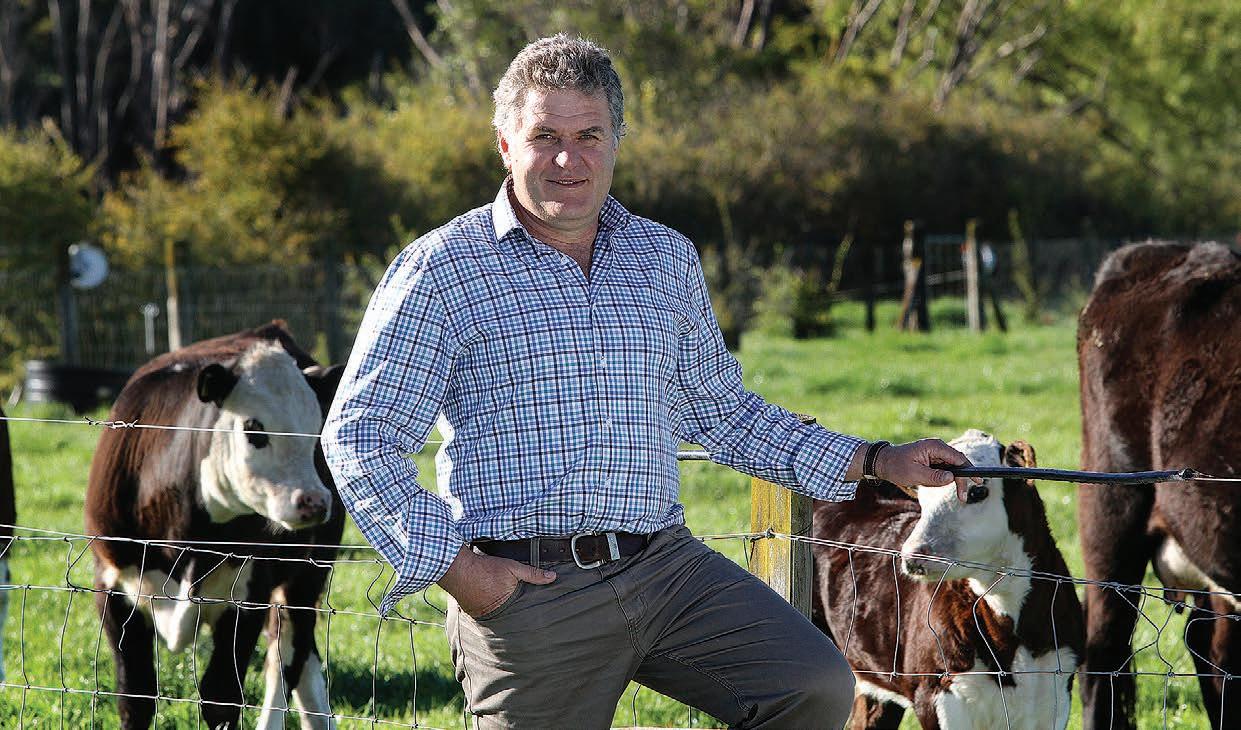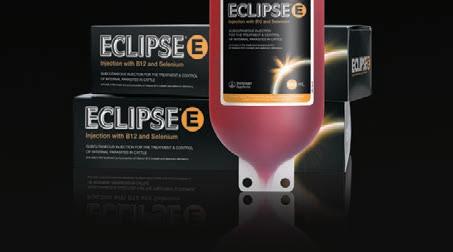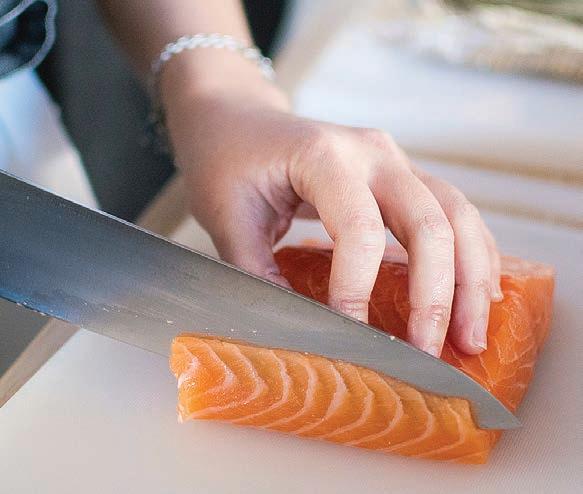
14 minute read
Pastoral enterprise game
News Pastoral enterprise game-changer
Annette Scott annette.scott@globalhq.co.nz
GOVERNMENT is backing a $20 million programme that could prove game-changing for pastoral enterprises looking to take environmental leadership.
Through its Sustainable Food and Fibre Futures fund (SFFF), the Ministry for Primary Industries (MPI) is partnering with Lincolnbased Leaft Foods to develop technology that extracts edible protein from New Zealand-grown green leafy crops.
Leaft Foods is investing $12m and MPI is contributing $8m to the five-year programme that has potential to put NZ on the map as a leading leaf protein concentrate producer.
Agriculture Minister Damien O’Connor says a growing number of global food manufacturers and consumers are demanding their proteins come from a sustainable source.
“This could be a game-changer for pastoral enterprises seeking to take environmental leadership, by providing them with a lowimpact, locally-sourced feed, and the opportunity to diversify into low emission farm systems,” O’Connor said.
“This project is exciting. We want to push the boundaries with new innovative development looking further into the future connecting to the values of those who are going to purchase our foods in the future.
“If this goes well there will be huge returns.”
The programme aims to build on NZ’s reputation as a trusted exporter of highquality protein, while reducing the environmental impact of agricultural systems.
It aims to meet the increase in demand for plant proteins in a way that aligns with changing consumer values.
Leaft Foods’ technology will be used to produce high-quality protein in the form of gels or powders that can be used in a range of foods in the fastgrowing global market for plant proteins.
“This programme is a great example of the types of innovation and value-add we’re calling for through our food and fibre sector roadmap Fit for a Better World – Accelerating our economic potential,” he said.
The plant-based protein start-up will also produce an animal feed that is optimised for ruminant nutrition and has the potential to lower nitrogen losses and emissions on-farm.
The programme will develop technology that extracts edible protein from NZ-grown green leafy crops.
While most of the current research has been looking at lucerne, other crops such as ryegrass, oats and white clover can be used in varying models to fit farming systems in all regions across the country.
Leaft Foods seeks to produce high-quality protein ingredients for use in a range of food products across the rapidly growing global market for plant-based foods.
Leaft Foods’ innovation is the co-production of a low-emission animal feed, optimised for ruminant nutrition that could significantly reduce farm nitrogen losses.
On-farm trials will demonstrate a viable pathway to adoption and commercial uptake for NZ farmers, and credentialing the system’s economic and environmental benefits.
“We are building on NZ’s reputation as a trusted producer of high-quality protein,” Leaft Foods founder Maury Leyland Penno said.
“Our vision is to reduce the environmental impact of agricultural systems and to meet the increase in demand for plant proteins that align with consumer values.
“More consumers are seeking out tasty and nutritious plant-based foods, which is apparent when you look at how supermarket shelves have changed over the past few years.
“Our mission is to demonstrate the viability of a sustainable and market-responsive farming system.
“Backing from MPI accelerates our ability to do that and places us in the leading pack of global food innovators.
General manager Ross Milne says Leaft Foods is now expanding on successful preliminary research and building a specialist team of people, including food technologists, process engineers and farm systems technicians, to deliver the pre-commercialisation programme.
GREEN GOODNESS: From left, Leaft Foods farm systems technician Sonja Vreugdenhil, Agriculture Minister Damien O’Connor and Leaft Food founders John Penno and Maury Leyland Penno and general manager Ross Milne with the plant-based products that’s part of the $20 million research and development programme. Photo: Annette Scott
Damien O’Connor Agriculture Minister
Have you read Dairy Farmer yet?

The latest Dairy Farmer hit letterboxes on March 29.
Our OnFarmStory this month features Waikato farmers Brian Vergeest and Sheryl Hamilton who contract milk 1000 cows for Southern Pastures in Manako.

We also catch up with the new chair of the DairyNZ Climate Change Ambassadors, and take a look at what is happening around health and safety on the farm.
11
APRIL 2021 | $8.95
Finding the sweet spot
Waikato farmers’ journey to make their farm sustainable and profitable
PLUS: Giving farmers a voice
➜ Farmer representation matters ➜ Tackling climate change ➜ Milk may help fight against covid
Hort soaks up investments
Hugh Stringleman hugh.stringleman@globalhq.co.nz
GREY clouds on the horizon have not reduced MyFarm’s willingness to syndicate horticultural developments, chief executive Andrew Watters says.
Towards the end of autumn harvesting for kiwifruit, apples, hops and avocados, he says the challenges are diverse but the margins and rewards are sufficient to continue.
“Yes, there are some clouds on the horizon, but clouds bring rain,” Watters said.
Two large MyFarm hop syndicated properties near Motueka were not in the path of hailstorms that hammered hop gardens, kiwifruit and apple orchards, vineyards and tunnel houses in the Nelson province on Boxing Day.
Hop growers estimate the industry will harvest only 40-60% of their expected volumes this season.
Watters says yields on the two 100ha-plus properties, called Tapawera and Wairua, planted and managed by partners Hop Revolution, were above estimates for all but one of the varieties grown.
“If you were hit by hail that was devastating but if not, then it has been quite a good year,” he said.
Labour shortages were evident throughout the Hawke’s Bay apple harvest and some lower value crops will remain on the tree because they are marginally economic to pick.
“Everyone is making do, but we wouldn’t want another year with these shortages of labour, that’s for sure,” he said.
Watters says prospective bidders for SunGold kiwifruit licences are keeping their cards close to their chests and he expects that successful bids will be higher than last year’s $400,000/ ha.
“The margins that can be obtained on SunGold means there will be a strong demand for licences,” he said.
When the proposed Kakariki Fund for horticulture in 2019 attracted only $30 million worth of investors instead of the $40m to $100m targeted, three planned developments went ahead as standalone syndicates.
These are the Otamarakau gold kiwifruit orchard, the Wairua hop garden and another Rockit apple orchard.
Kakariki Fund has been wound up and the name removed from the Companies Register.
Although 2020 was an extraordinary year, MyFarm put together $185m of horticultural and commercial property investments with funding from 800 people, about half of whom were repeat investors, varying according to the type of proposal.
Among investment offers under way this year are a 1000ha manuka planting with Comvita and two SunGold kiwifruit orchards.
Watters says MyFarm would look at more close-planting avocados, green kiwifruit and more manuka.
He would not rule out a return to dairy syndicates, where MyFarm began 30 years ago, now that five good milk price seasons have helped farmers and investors recover from two loss-making seasons.
“Horticulture has got many good aspects and probably easier from an environmental perspective,” he said.
The Te Arai Gold Partnership offer at Muriwai, near Gisborne, is for a total of $13.24m to be raised and $9.9m borrowed from the bank.
Partnering with post-harvest operator Apata, MyFarm has an offer to buy 28ha of suitable land for a 20ha SunGold covered orchard, conditional on licences being obtained this year and next.
Total development, including Zespri licence, is expected to cost just over $1m/ha and the promoters have forecast around $200,000/ha crop revenue at full production.

CONFIDENCE: Horticulture remains the focus of MyFarm syndicates says chief executive Andrew Watters, although he did not rule out a return to dairying.
THE CONVENIENCE OF TWO TREATMENTS IN ONE INJECTION
One month to go on buy-back

THE firearms buy-back ends on May 1, so police are reminding people who have any prohibited firearms, or other specified items, to get in touch and hand them in.
“People need to apply for compensation by May 1 at a police station, so if you haven’t already, it’s time to come and hand them in,” Inspector Richard Wilson says.
Police encourage people to look at the amnesty-andbuy-back section on the www. police.govt.nz website if they have any specified items to bring in for compensation.
“Just give us a call on 0800 311 311 or email buyback2021@ police.govt.nz to organise a time to meet someone at a station to hand over your items,” Wilson said.
“We’ve worked hard to make it as simple as possible because we know that our firearms community was key to the success of the last buy-back.”
When you bring your items to a police station, please remember to: • Transport your firearm/s and items safely and securely in a soft firearms bag or lockable hard transit case. • Ensure no firearms or magazines are loaded, and please remove all detachable magazines. • Ensure you bring photo identification with you, such as your firearms licence, driver licence, or passport. • Have your bank account number and proof of bank account, to ensure police have your correct details
“This new group of prohibited and restricted items is much smaller than the group in 2019, which has meant we have been able to take a more individualised approach,” he said.
After May 1, items are still able to be handed in under amnesty, without compensation, until August 1.
The world’s first dual action, broad spectrum injectable parasite control, with the addition of B12 and selenium to support growth and energy in young cattle.



Online tool to trace velvet
Annette Scott annette.scott@globalhq.co.nz
A NEW electronic track and trace system for velvet is set to make life easier for deer farmers, while also providing proof of integrity from the farm to market.
VelTrack, a fully electronic, webbased system that enables velvet to be tracked and traced each step of the way from the farm to the market, and vice-versa, is set for first registrations on April 6.
It will mean farmers will not be required to record tag numbers, fill out paper velvet status declarations (VSDs) or need to have a scanner.
Deer Industry New Zealand (DINZ) chief executive Innes Moffat says good progress is being made with the rollout of VelTrak in readiness for the 2021-22 velvet season.
Major velvet buyers and warehouses have placed their orders for the Zebra brand UHF RFID scanners that will play a key role in VelTrak.
Moffat says farmers and vets will not need to buy a scanner.
Early ordering was needed so DINZ could negotiate a bulk price for the scanners and get them delivered in time for scanner operators to be trained.
Delivery is expected in May, with hands-on operator workshops planned accordingly.
“The scanners are a significant investment for buyers and warehouses, so it is great to get their support,” Moffat said.
VelTrak builds on the work done by farmers to upgrade their sheds and freezers to comply with the Ministry for Primary Industries (MPI) Regulated Control Scheme (RCS).
It will also underpin the premium position that NZ velvet now enjoys in South Korea.
“It will enhance our reputation as trusted producers when marketing our velvet to health food companies in China, Taiwan and elsewhere,” he said.
At this stage farmers do not need to do anything about VelTrak other than to ensure they have a functioning email address, DINZ quality assurance manager John Tacon says.
The action starts for farmers in early May when online registration opens; farmers will receive an email inviting them to register.
“All they (farmers) need is an email address and web access to approve electronic VSDs (eVSDs),” Tacon said.
Farmer webinars focused on how the VelTrak system works, the importance of applying tags correctly and how to approve the new VelTrak eVSDs are being planned.
VelTrak registration will be needed for all businesses involved in velvet removal, purchase, warehousing, processing and export from the start of the 202122 season.
For farmers to sell their velvet into the human food chain, they must be registered with VelTrak and tag their velvet with the new VelTrak tags.
This applies to farmers who are NVSB-accredited to do their own velveting, as well as those who get a vet to do their velveting.
While designed to make compliance easier for farmers, it will also make it difficult for anyone velveting in unregistered facilities and outside NZ industryagreed standards to sell their velvet.
“If your deer farm, clinic or business is known to DINZ and you are designated as the main DINZ contact, registration instructions will be automatically emailed to you,” he said.
Deer vets, velvet buyers and warehouses are the first cabs off the rank for registration opening on April 6.
Deer farmer registration opens on May 3.
“If you haven’t heard from us by your respective registration opening dates, please contact us,” Moffat said.
John Tacon Deer Industry NZ

GO TIME: DINZ chief executive Innes Moffat says good progress is being made with the new system ahead of the 2021-22 velvet season.
MORE:
To learn more about VelTrack go to: www.deernz.org/VelTrak
Domestic sales boost salmon recovery
Hugh Stringleman hugh.stringleman@globalhq.co.nz
NEW Zealand King Salmon has struggled with covid-19 sales disruptions and higher freight costs to declare a sharply reduced net profit for seven months of trading until January 31.
The company has moved its financial year and balance date to align with summer seasonality of fish production.
The latest results suffered in comparison with a healthier pre-covid corresponding period, throughout late 2019.
Revenue was $95.2 million, down 6% on the seven months to January 31, 2020.
Gross margin took a hit of 42% and earnings before interest, tax, depreciation and amortisation (Ebitda) were down 49% to $9.9m.
Pro-forma net profit was 77% to $2.35m and when GAAP adjusted it was a statutory loss of $7m compared with a profit of $18m in the full 12 months of FY20.
Chair John Ryder called it a creditable outcome considering the impact of the covid-19 pandemic.
“The full financial impact of excess inventory, caused by the pandemic, has been absorbed into these results with appropriate contingencies built in,” Ryder said.
“Going forward, our average price will return to pre-covid levels, however, margins will still be affected by higher freight and distribution costs.
“We are seeking to increase prices globally around the middle of the calendar year, with a view to recovering some of these ongoing costs.
“Pleasingly, we have come through summer in reasonable shape with sea temperatures around average.”
Chief executive Grant Rosewarne says the company continued to innovate and invest, develop new brands and launch new products.
Monthly sales volumes from March to August last year were well down on their 2019 comparison, but have now recovered with the assistance of retail promotions in the domestic market.
NZ sales are 43% of the total, Australian 7% and the United States and Canada 36%.
In North America new sales channels such as fishmongers, specialty retail and online ordering are replacing the loss of foodservice demand.
“Disruption to exports and foodservice have created the opportunity to renew domestic retail interest, grow the market and build brand awareness,” Rosewarne said.
He says the company was planning for annual production between 10,000 and 11,000 tonnes from existing in-shore farm sites, but future harvest volumes were impacted by consent and compliance challenges.
He says the proposed open ocean site development in Cook Strait should go to a consent hearing later this year.

FOCUS: Monthly sales volumes from March to August last year were well down on their 2019 comparisons, but have now recovered with the assistance of retail promotions in the domestic market.
LARGE FORMAT RETAIL FUND
STRONG SECTOR PERFORMANCE
SIGNIFICANT INITIAL ASSET

QUALITY TENANTS SOUGHT-AFTER LOCATION
PIE STRUCTURE
5.0 % p.a.
PAYABLE MONTHLY
Minimum investment $50,0002 ALBANY LIFESTYLE CENTRE | 260 OTEHA VALLEY ROAD, ALBANY, AUCKLAND
Contact us to register your interest and for a copy of the Product Disclosure Statement.
Charlie Oscroft 021 824 564 charlie.oscroft@colliers.com


